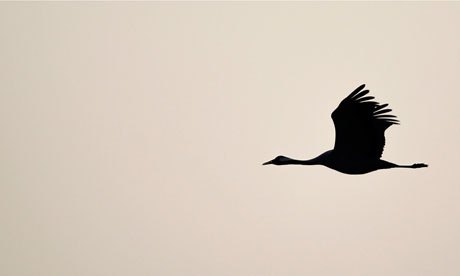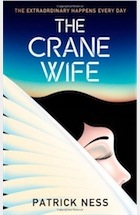Ursula K Le Guin on an unusual novel of elemental emotion and great kindliness

Highly staged drama is mixed with deliberate deflation, as when George first sees the crane. Photograph: Atef Safadi/EPA
In Patrick Ness's return to adult fiction after his prizewinning Chaos Walking trilogy, George – fortyish, divorced, American – hears a strange cry in the winter night, a keening (the word is italicised as if it were in a foreign language). He goes out to find a great white bird in his London back garden with an arrow in its wing. He removes the arrow and tells the crane his name; it bows and flies away, leaving George to do the keening.
 The legendary situation is clear and vivid, though its development in the novel is complicated by wandering focus and constant changes of narrative tone. In George's printing shop next day we meet his Turkish assistant Mehmet, an entertaining character. The chapter, like many in the book, consists almost entirely of inconsequential dialogue, and it ends suddenly with the entry of a customer, lent drama by the paragraphing and phrasing:
The legendary situation is clear and vivid, though its development in the novel is complicated by wandering focus and constant changes of narrative tone. In George's printing shop next day we meet his Turkish assistant Mehmet, an entertaining character. The chapter, like many in the book, consists almost entirely of inconsequential dialogue, and it ends suddenly with the entry of a customer, lent drama by the paragraphing and phrasing:
'"My name," she said, "is Kumiko."'
I thought the name Kumiko might signify the crane of the Japanese legend, but my computer tells me it means something more like "child of lasting beauty". Kumiko is a sweet and mysterious lady. George, a defencelessly amiable man, naturally falls in love with her, and she with him. She shows him an artwork she has made, an image cut from white feathers on a black tile. George's own hobby involves slicing old books up into slivers and shapes of paper and collaging them; under Kumiko's inspiration he slices up a book and by joining his creation to hers makes a tile of such wondrous and meaningful beauty that all who see it are amazed, burst into tears, and want to pay vast sums of money for it. Kumiko and George go on combining their artwork, and in no time they are both rich.
More
 The legendary situation is clear and vivid, though its development in the novel is complicated by wandering focus and constant changes of narrative tone. In George's printing shop next day we meet his Turkish assistant Mehmet, an entertaining character. The chapter, like many in the book, consists almost entirely of inconsequential dialogue, and it ends suddenly with the entry of a customer, lent drama by the paragraphing and phrasing:
The legendary situation is clear and vivid, though its development in the novel is complicated by wandering focus and constant changes of narrative tone. In George's printing shop next day we meet his Turkish assistant Mehmet, an entertaining character. The chapter, like many in the book, consists almost entirely of inconsequential dialogue, and it ends suddenly with the entry of a customer, lent drama by the paragraphing and phrasing:'"My name," she said, "is Kumiko."'
I thought the name Kumiko might signify the crane of the Japanese legend, but my computer tells me it means something more like "child of lasting beauty". Kumiko is a sweet and mysterious lady. George, a defencelessly amiable man, naturally falls in love with her, and she with him. She shows him an artwork she has made, an image cut from white feathers on a black tile. George's own hobby involves slicing old books up into slivers and shapes of paper and collaging them; under Kumiko's inspiration he slices up a book and by joining his creation to hers makes a tile of such wondrous and meaningful beauty that all who see it are amazed, burst into tears, and want to pay vast sums of money for it. Kumiko and George go on combining their artwork, and in no time they are both rich.
More
No comments:
Post a Comment